PONTIAC GRAND-PRIX 1993 Owners Manual
Manufacturer: PONTIAC, Model Year: 1993, Model line: GRAND-PRIX, Model: PONTIAC GRAND-PRIX 1993Pages: 338, PDF Size: 17.3 MB
Page 201 of 338
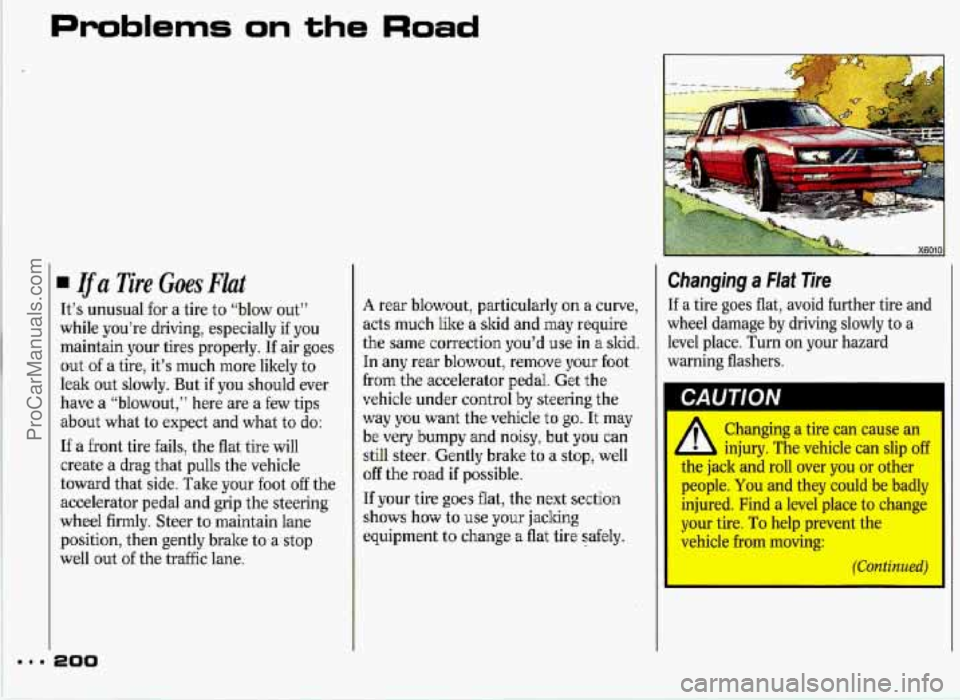
Problems on the Road
.I.
It’s unusual for a tire to “blow out”
while you’re driving, especially if
you
maintain your tires properly. If air goes
out
of a tire, it’s much more likely to
leak out slowly. But if you should ever
have
a “blowout,” here are a few tips
about what to expect
and what to do:
If
a front tire fails, the flat tire will
create a drag that pulls the vehicle
toward that side. Take your foot
off the
accelerator pedal and grip the steering
wheel firmly. Steer to maintain lane
position, then gently brake to a stop
well out of the traffic lane.
2010
A rear blowout, particularly cm a curve,
acts
much like a skid and may require
the same correction
you’d use in a skid.
In any rear blowout, remove pur bot
from the accelerator pedal. G,et the
vehicle under control by steering the
way
you want the vehicle to go. It may
be very bumpy and noisy, but you can
still steer, Gently brake to a stop, well
off the road if possible.
If your tire goes flat, the next se’ction
shows how
to use your jacking
equipment to change a flat tire safely.
Changing a Flat Tire
If a tire goes flat, avoid further tire and
wheel damage by driving slowly to a
level place. Turn
on your hazard
warning flashers.
A Changing a tire can cause an
injury. The vehicle can
slip off
the jack and roll over you or other
people.
You and they could be badly
injured.
Find a level place to change
your tire. To help prevent the
vehicle from moving: I
I (Continued)
ProCarManuals.com
Page 202 of 338
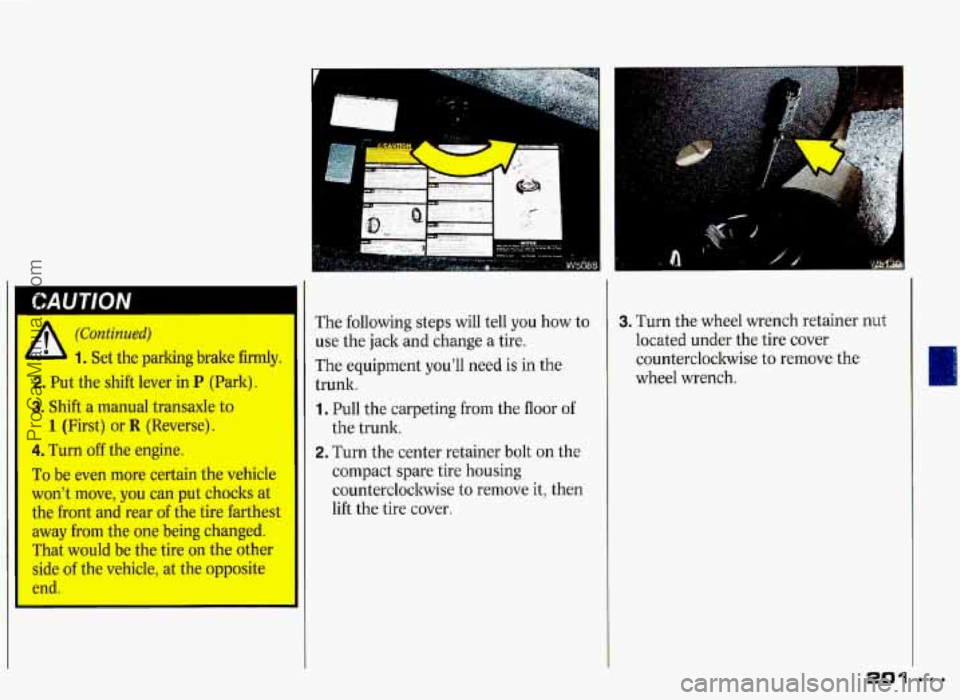
I I
CAUTION
(Continued)
1. Set the parking brake firmly.
2. Put the shift lever in P (Park)
3. Shift a manual transaxle to
1 (First) or R (Reverse).
4. Turn off the engine.
To be even more certain the vehicle
won’t move, you can put chocks at
the front and rear of the tire farthest
away from the one being changed.
That would be the tire on the other
side of the vehicle, at the opposite
end.
I
P====
The following steps will tell you how to
use the jack and change
a tire.
The equipment you’ll need is
in the
trunk.
1. Pull the carpeting from the floor of
the trunk.
2. Turn the center retainer bolt on the
compact spare tire housing
countercloclwise
to remove it, then
lift the tire cover.
3. Turn the wheel wrench retainer nut
located under the tire cover
counterclockwise to remove the
wheel wrench.
201
U
8..
ProCarManuals.com
Page 203 of 338
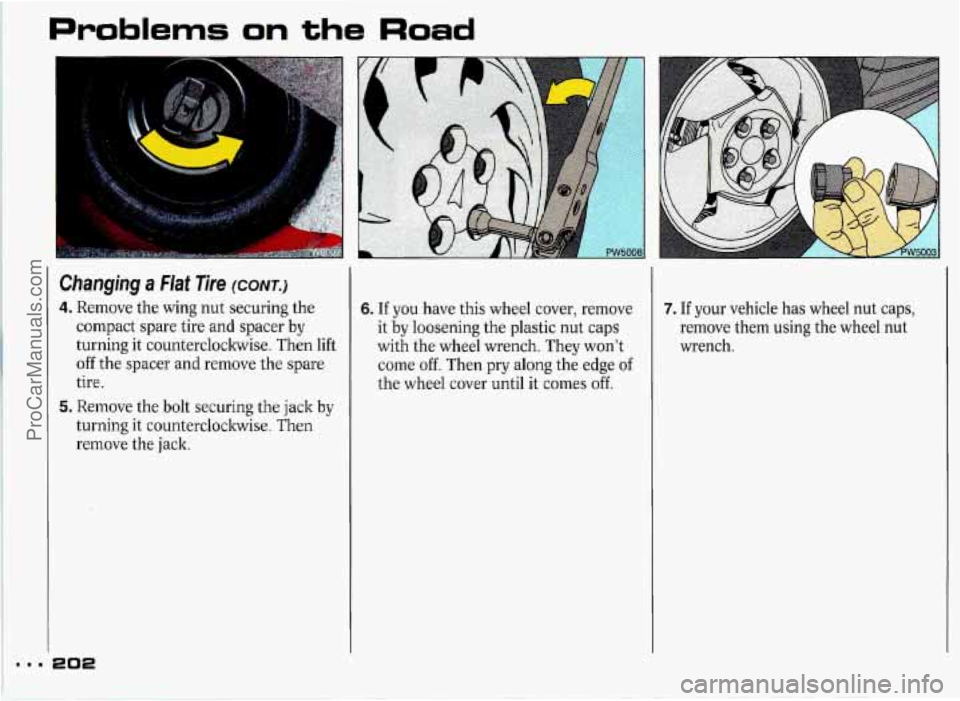
m..
Problems on the Road
Changing a Flat Tire (CONT.)
4. Remove the wing nut securing the
compact spare tire and spacer
by
turning it countercloclnvise. Then lift
off the spacer and remove the spare
tire.
5. Remove the bolt securing the jack by
turning it countercloclwise. Then
remove the jack.
202
6. If you have this wheel cover, remove
it by loosening the plastic nut caps
with the wheel wrench. They won't
come off. Then pry along the edge
of
the wheel cover until it comes off.
7. If your vehicle has wheel nut caps,
remove them using the wheel nut
wrench.
ProCarManuals.com
Page 204 of 338
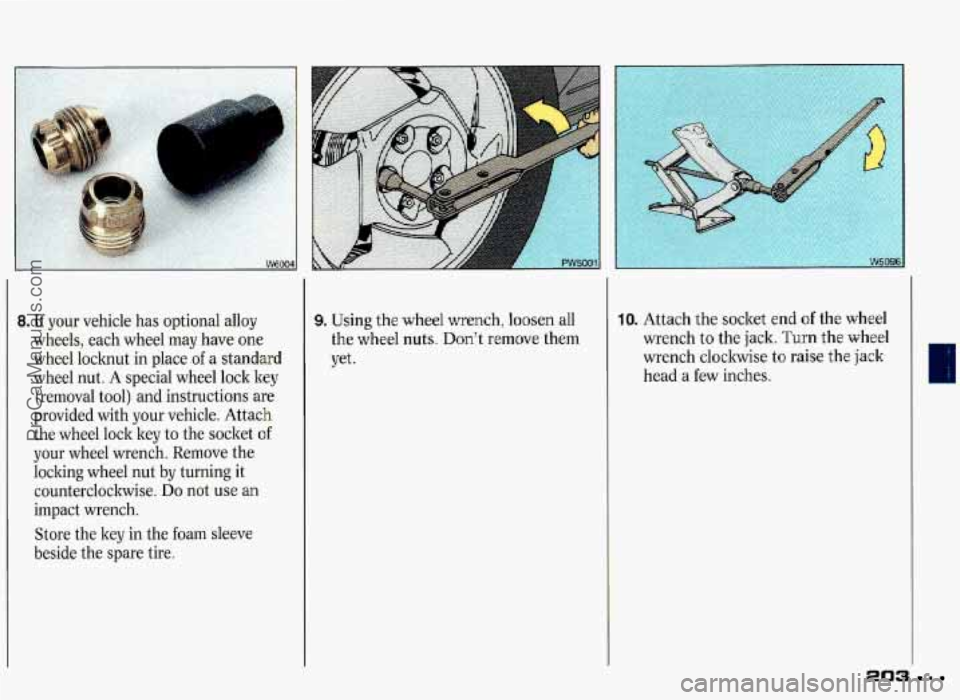
8. If your vehicle has optional alloy
wheels, each wheel may have one
wheel locknut in place
of a standard
wheel nut. A special wheel lock key
(removal tool) and instructions are
provided with your vehicle. Attach
the wheel lock key to the socket
of
your wheel wrench. Remove the
locking wheel nut by turning it
counterclockwise.
Do not use an
impact wrench.
Store the key in the foam sleeve
beside the spare tire.
9. Using the wheel wrench, loosen all
the wheel
nuts. Don't remove them
yet.
10. Attach the socket end of the wheel
wrench to the jack.
Turn the wheel
wrench clockwise to raise the
jack
head a few inches.
203
ProCarManuals.com
Page 205 of 338
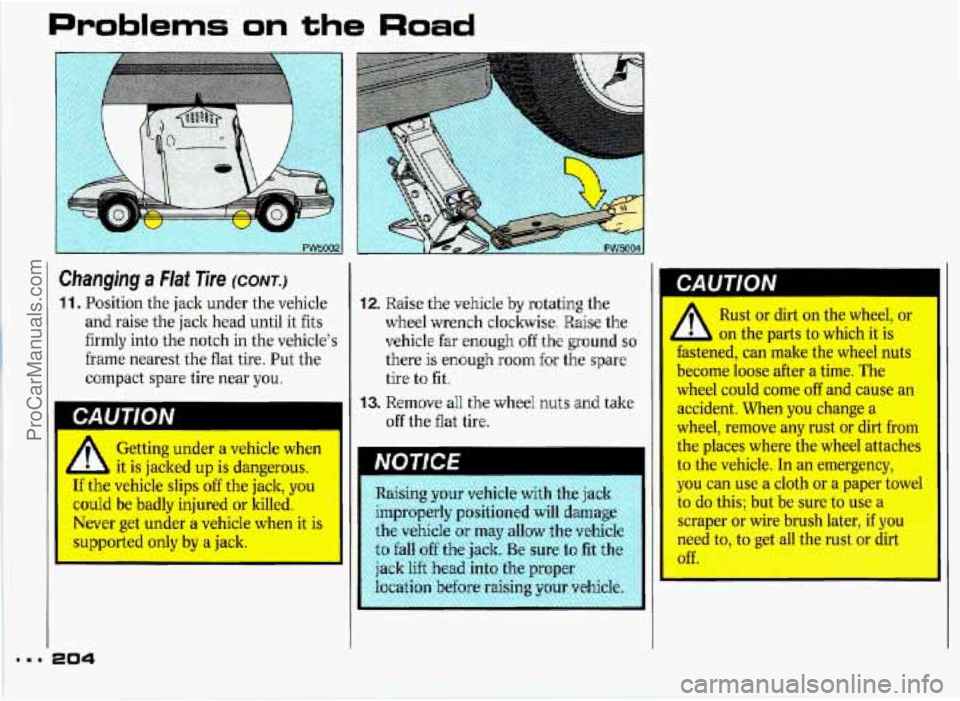
Problems on the Road
Changing a Hat Tire (CONT.)
11. Position the jack under the vehicle
and raise the jack head until it fits
firmly into the notch in the vehicle’s
frame nearest the flat tire. Put the
compact spare tire near
you.
LAU f IVN
Getting under a vehicle when
L it is jacked up is dangerous.
If the vehicle slips off the jack, you
could be badly injured or killed.
Never get under
a vehicle when it is
supported.
only by a jack.
12. Raise the vehicle by rotating the
wheel wrench cloclwise.
Raise the
vehicle far enough
off the ground so
there is emugh morn for the spare
tire to fit.
13. R’ernove all the u7heel nuts and take
off the flat tire.
~~ ~
I Kaising your vehicle with the jack
improperly positioned will damage
the vehicle
or may allow the vehicl,
to fall
off the jack. Be sure to fit the
jack lift head into the proper
location before raising your vehick Rust
or dirt on the wheel, or
4 b on the parts to which it is
fastened, can make the wheel nuts
become loose after a time. The
wheel could come off and cause an
accident. When you change a
wheel, remove any rust
or dirt from
the places where the wheel attaches
to the vehicle. In an emergency,
you can use a cloth or a paper towel
to do this; but be sure to use a
scraper or wire brush later, if you
need
t ;et all 1 rust or dirt
L
(
ProCarManuals.com
Page 206 of 338
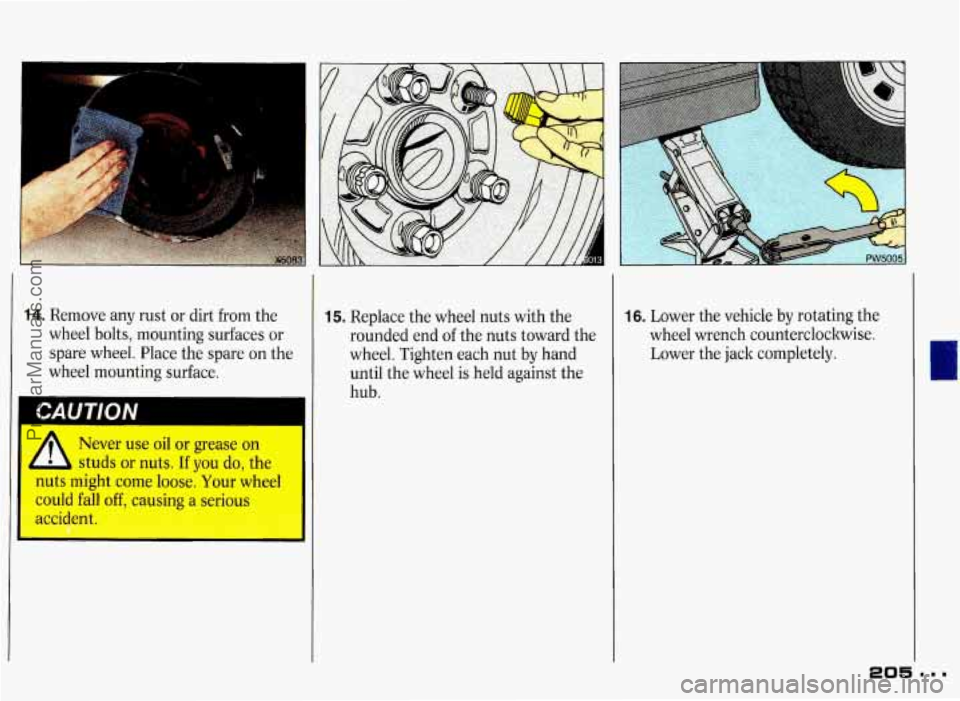
14. Remove any rust or dirt from the
wheel bolts, mounting surfaces or
spare wheel. Place the spare on the
wheel mounting surface.
--
, Never use oil or grease on I
studs or nuts. If you do, i 3
luts might come loose. Your wheel
.Id fall off, causing a seril 1
accident. I
15. Replace the wheel nuts with the
rounded end
of the nuts toward the
wheel. Tighten each nut by hand
until the wheel is held against the
hub.
16. Lower the vehicle by rotating the
wheel wrench countercloclwise.
Lower the jack completely.
205
u
ProCarManuals.com
Page 207 of 338
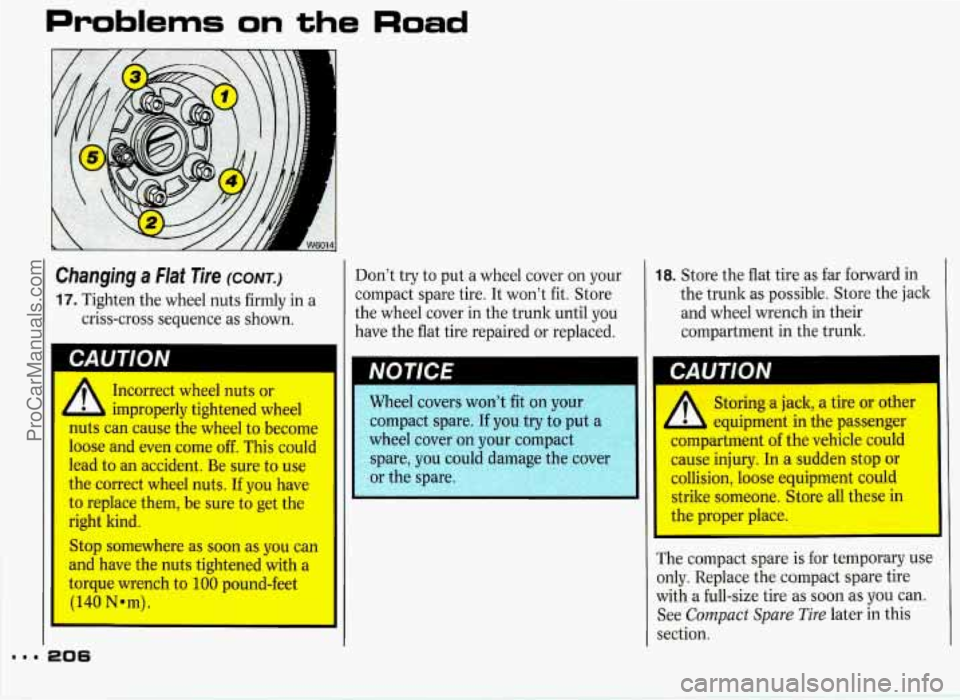
Problems on the Road
Changing a Flat Tire (CONT.)
17. Tighten the wheel nuts firmly in a
criss-cross sequence as shown.
11 CAUTION 'I
Incorrect wheel nuts or
improperly tightened wheel
nuts can cause the wheel to become
loose and even come off. This could
lead to an accident. Be sure to use
the correct wheel nuts.
If you have
to replace them, be sure to get the
right kind.
Stop somewhere as soon as you can
and have the nuts tightened with a
torque wrench to
100 pound-feet
(140 Nmm).
Don't try to put a wheel cover on your
compact spare tire.
It won't fit. Store
the wheel cover in the trunk until you
have the flat tire repaired or replaced.
I meel covers won't fit on your
compact spare. If you try to put
a
wheel cover on your compact
spare, you could damage the cover
or the spare.
I
18. Store the flat tire as far forward in
the trunk as possible. Store the jack
and wheel wrench in their
compartment in the trunk.
Storing
a jack, a tire or other
equipment in the passenger I
compartment of the vehicle could
cause injury.
In a sudden stop or I
collision, loose equipment could
strilce someone. Store all these
in
the proper place. I
The compact spare is for temporary use
only. Replace the compact spare tire
with a full-size tire as
soon as you can.
See
Compact Spare Tire later in this
section.
ProCarManuals.com
Page 208 of 338
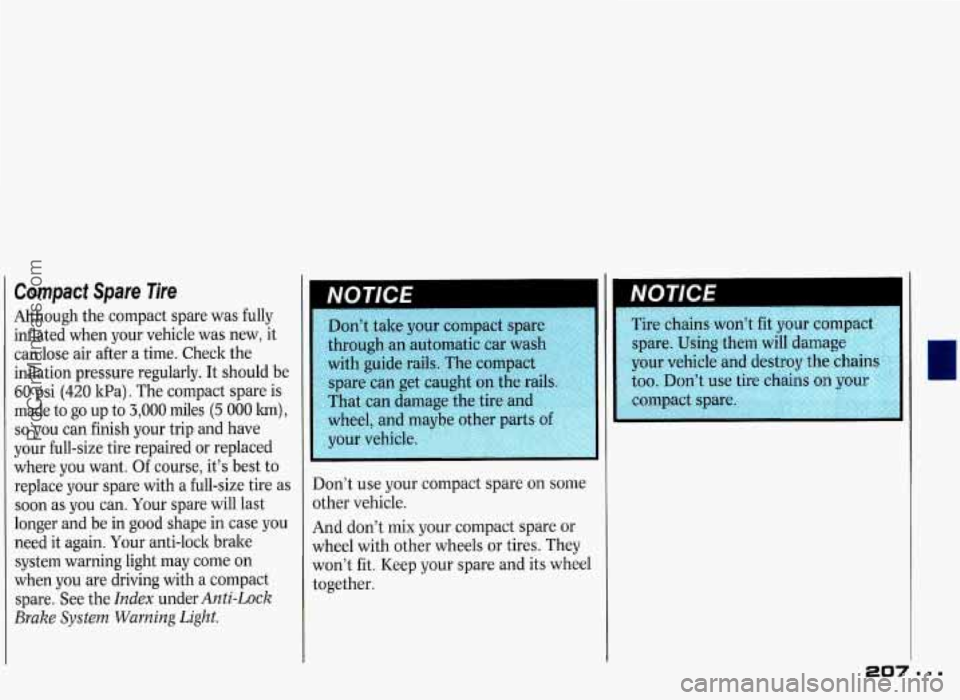
Compact Spare Tire
Although the compact spare was fully
inflated when your vehicle was new, it
can lose air after a time. Check the
inflation pressure regularly. It should be
60 psi (420 1tPa). The compact spare is
made to go up to 3,000 miles (5 000 lm),
so you can finish your trip and have
your full-size tire repaired or replaced
where you want. Of course, it’s best to
replace your spare with a full-size tire as
soon as you can. Your spare will last
longer and be in good shape in case you
need it again. Your anti-lock brake
system warning light may come on
when
you are driving with a compact
spare. See the
Index under Anti-Lock
Brake System Warning Light.
take your compact spare
through an automatic car wash
with guide rails. The compac
spare can get caught
on the r
That can damage the tire and
wheel, and ma
your vehicle
Don’t use your compact spare on some
other vehicle.
And don’t mix your compact spare or
wheel with other wheels or tires. They
won’t fit. Keep your spare and its wheel
together.
NU I IL‘t
Tire chains won’t fit your compact
spare. Using
them will damage
your vehicle and destroy the chains
too. Don’t use tire chai
ProCarManuals.com
Page 209 of 338
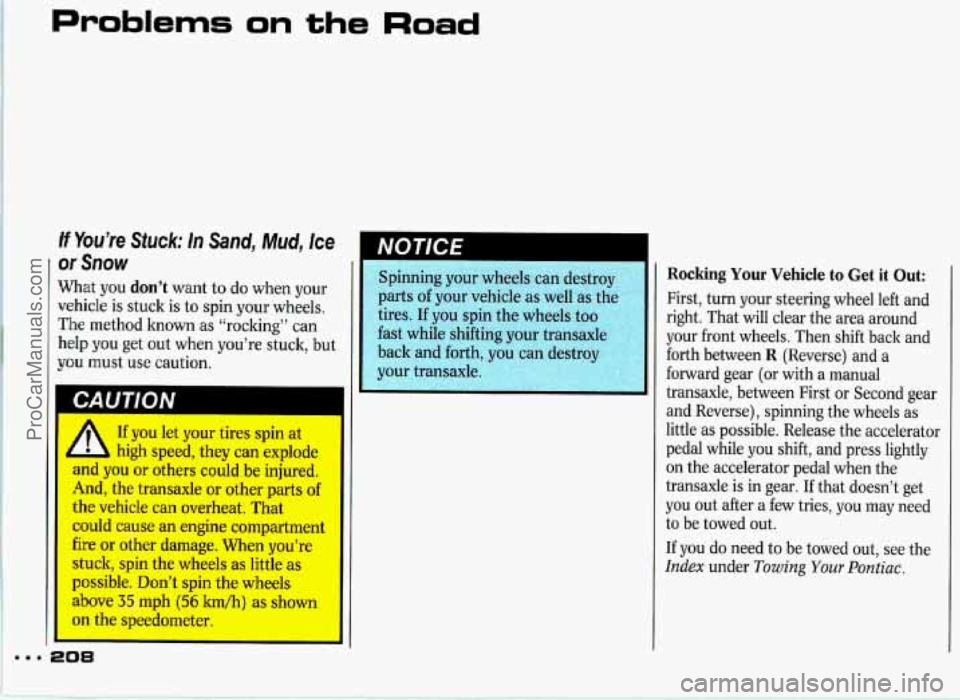
Problems on the Road
if You’re Stuck: In Sand, Mud, Ice
~ or Snow
What you don’t want to do when your
vehicle is stuck
is to spin your wheels.
The method known as “rocking” can
help
you get out when you’re stuck, but
you must use caution.
CAUTION
~ Spinning your wheels can destroy
parts
of your vehicle as well as the
tires.
If you spin the wheels too
fast while shifting your transaxle
back and forth, you can destroy
your transaxle.
If
you let your tires spin at
b high speed, they can explode
llyu you or others could be injured.
And, the transaxle or other parts of
the vehicle can overheat. That
could cause an engine compartment
fire
or other damage. When you’re
stuck, spin the wheels as little
as
possible. Don’t spin the wheels
above
35 mph (56 h/h) as shown
on the speedometer.
I
Rocking Your Vehicle to Get it Out:
First, turn your steering wheel left and
right. That will clear the area around
your front wheels. Then shift back and
forth between
R (Reverse) and a
forward gear (or with a manual
transaxle, between First or Second gear
and Reverse), spinning the wheels as
little as possible. Release the accelerator
pedal while you shift, and press lightly
on the accelerator pedal when the
transaxle is in gear.
If that doesn’t get
you out after a few tries, you may need
to be towed out.
If you do need to be towed out, see the
Index under Towing Your Pontiac.
ProCarManuals.com
Page 210 of 338

Notes
ProCarManuals.com